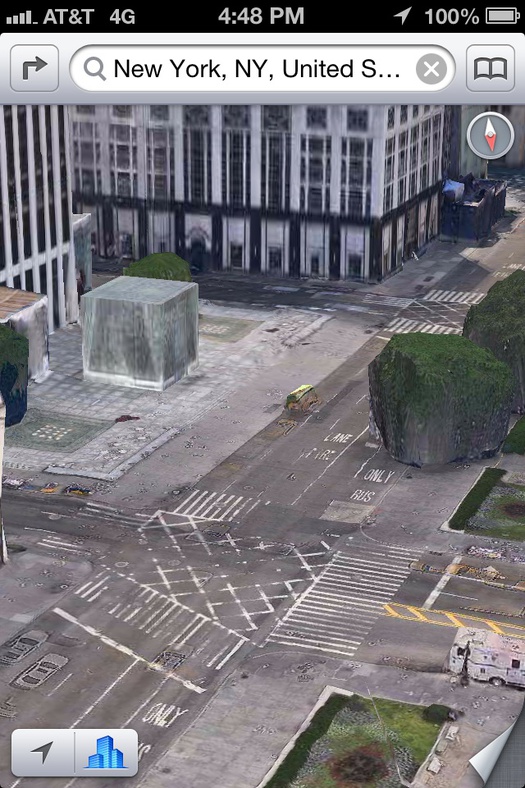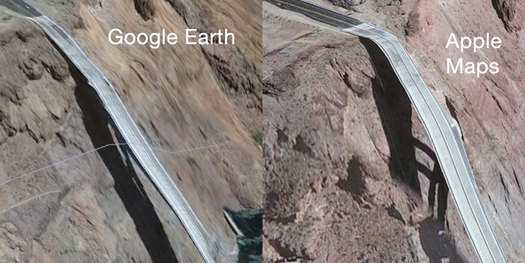
September 25, 2012
Crowdcrit vs. Apple Maps
The debate over the relative merits of “amateur” (or “citizen,” if you like) critics has meandered on for more than a decade now. Still, there’s a subset of the genre that deserves more attention: you could call it the crowd critique — or let’s just be snappy and say crowdcrit. It roared into view last week in response to Apple’s new iOS 6 Maps app.

“That big green blob is in a 5th Avenue bus lane,” via The Amazing iOS 6 Maps
Professional critics of course responded to this alternative to Google Maps now being foisted on iOS users — Slate has a a largely negative assessment here, for instance. But the most crushing, and practically instantaneous, critique emerged in the form of a submission-driven Tumblr, The Amazing iOS 6 Maps (“The Apple iOS 6 Maps are amazing. Not”), offering a barrage of glitches, errors, and failures that users have found in scrutinizing the new Maps. As Xeni Jardin observed: “You know you have an issue when someone brews up a Tumblr to mock you.” Very true. This Tumblr began on Thursday and a glance at its archive makes it clear that there was plenty to post from the get-go. Not surprisingly, the Slate review bolstered its case with examples culled from the Tumblr, as well as a Twitter hashtag (#MapsFail). “Users Blast Maps Switch,” the lead story in Friday’s Wall Street Journal announced.
But can a Tumblr collecting scads of images from far-flung contributors, with very little text and no real attempt at traditional analysis, really be considered a form of “criticism”? Yes. And in this case the result is surprisingly enjoyable, as some of the glitches have produced accidentally pleasing surrealist cityscapes — a monstrous green shape seems to menace Fifth Avenue, Interstate 10 buckles toward cubism, airport runways undulate, and the application informs us that gas stations can be found atop Houston skypscrapers.

Highway challenge, via The Amazing iOS 6 Maps

“Those are corporate headquarters, not gas stations,” via The Amazing iOS 6 Maps
This instance certainly demonstrates that crowdcrit can offer an extremely persuasive critique, overwhelming in its specific examples on a level no single pro could hope to match. (It might even be unfairly persuasive: You can find built-environment impossibilities through Google, too, as this Amazing iOS 6 Maps post notes. Clement Vella offers up some beguiling examples collected from Google Earth in this piece for Rhizome. That said, many of the Tumblr’s examples are more straightforward instances of practical geographic mistakes.)

“Terrain maps don’t know where structures are,” via The Amazing iOS 6 Maps.
One of the most productive assessments of the non-pro criticism the Web makes possible appeared, as it happens, in these (Web)pages: Alice Twemlow, in 2010, pointed to a funny Amazon review of a cat toilet as an example of “a democratizing impulse in design criticism” — democratizing in terms of what gets critiqued as well as who gets to be a critic. I want to push a little further by de-emphasizing the importance of any individual author in such cases; crowdcrit is effective partly because its authorship is diffuse, collective, and accretive. In fact the more abstract the authorship gets, the more effective the results can be.
This would make crowdcrit difficult to anthologize, of course, but it’s a thing to be reckoned with just the same. Admittedly, many prior instances I can think of tend to involve obscurities. But I’d argue that, say, the deluge of absurd Amazon reviews for a “banana slicer” has a kind of critical value, making a statement about how bizarre and nonsensical product culture can get, and doing so as well as any pro critic could (at least any pro critic limited to making the point solely by addressing a banana slicer). A crowdcrit assault on “Bic For Her” pens underlined the stupidity and offensiveness of object-gendering; it’s hard to miss the point of complaints on the pricing of a Hasselblad served up by crowdcrit; and so on. (And aside from Apple’s Maps, another example of a non-obscure crowdcrit victim: The Bible.)

“Prepare for some turbulence,” via The Amazing iOS 6 Maps
Given all the recent debate about how negative critics should or shouldn’t be, it’s notable that crowdcrit is all about the devastating takedown. Or is it? Surely Three Wolf Moon is crucial to this genre’s canon, and in that case the apparent mockery made the object a beloved and desirable (well, to some) artifact. This connects crowdcrit to ROFLculture (a subject for another time) but also brings us back to the anti-Maps Tumblr, which in addition to making a highly convincing critical case, is both imaginative and pleasurable. You really don’t have to care one way or the other about iPhone software to be drawn in by the uncanny imagery the site collects.
Here, I would say, crowdcrit has it over the takedowns offered by most pros, which certainly can be intrinsically entertaining, but frequently aren’t. Not that I’m against takedowns, per se: I just find it more impressive when someone finds a way to creatively destroy a deserving target. I think that’s a noble goal, and that crowdcrit has offered us some pretty inspiring examples of reaching it.
Oh, and P.S.: Swiss Miss has pointed out a workaround for getting Google Maps back on your iOS 6 desktop, here.
Observed
View all
Observed
By Rob Walker
Related Posts

Equity Observer
L’Oreal Thompson Payton|Essays
‘Misogynoir is a distraction’: Moya Bailey on why Kamala Harris (or any U.S. president) is not going to save us

Equity Observer
Ellen McGirt|Essays
I’m looking for a dad in finance

She the People
Aimee Allison|Audio
She the People with Aimee Allison, a new podcast from Design Observer

Equity Observer
Kevin Bethune|Essays
Oh My, AI
Recent Posts
Make a Plan to Vote ft. Genny Castillo, Danielle Atkinson of Mothering Justice Black balled and white walled: Interiority in Coralie Fargeat’s “The Substance”L’Oreal Thompson Payton|Essays
‘Misogynoir is a distraction’: Moya Bailey on why Kamala Harris (or any U.S. president) is not going to save us New kids on the bloc?Related Posts

Equity Observer
L’Oreal Thompson Payton|Essays
‘Misogynoir is a distraction’: Moya Bailey on why Kamala Harris (or any U.S. president) is not going to save us

Equity Observer
Ellen McGirt|Essays
I’m looking for a dad in finance

She the People
Aimee Allison|Audio
She the People with Aimee Allison, a new podcast from Design Observer

Equity Observer
Kevin Bethune|Essays

 Rob Walker is a technology/culture columnist for
Rob Walker is a technology/culture columnist for